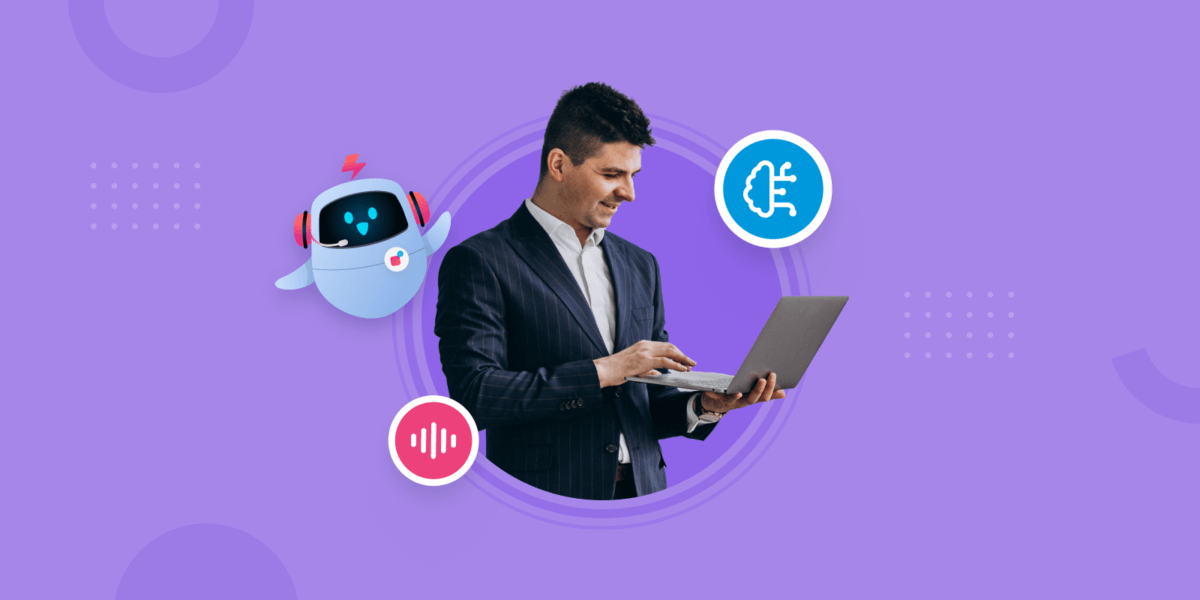Types of Customer Support: Phone vs Conversational AI
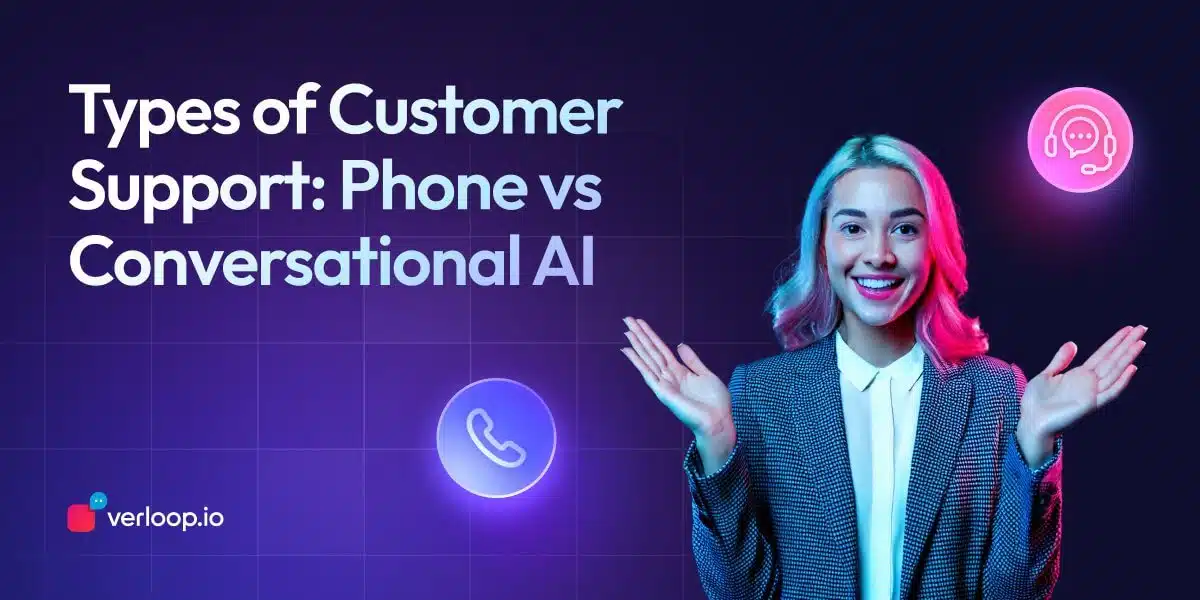
Types of Customer Support: Phone vs Conversational AI
Wondering which support is better for your company: phone or conversational AI? In this article, we compare the support methods to find the answer.
Phone vs conversational AI — both provide a quick response. But the experience is as different as it can get. In this blog, we look at the pros and cons of both support methods, which will help you understand which is better for your company.
With the increasing range of technology penetration in our lives, the number of communication channels has also increased considerably. This rise has resulted in the opening up of communication options for organisations to reach out to their current and potential customers.
But with their limited resources, organisations often have to choose the ones with higher suitability to their business needs.
Phone support has been one of such choices from the very start of customer care services. However, with increased tech orientation, the world is now shifting towards Conversational AI chatbots.
What is phone support?
When we avail customer support services on a call, it falls under the category of phone support.
Everyone has had some experience with getting their problems solved on a phone call. Though phone support is not as popular as it used to be, statistics still show a favourable picture for phone support.
Its best application is the resolution of complex problems that become hard to solve on a text message.
Customer care executives can use their interpersonal skills to make people more comfortable and confident in the organisation. This can go a long way in building relationships and brand loyalty.
Pros of phone support
a. Feels more personal: Dialling a company and hearing a human voice feels far more personal than a machine trying to solve your issues. A human can also be trained in terms of expressing empathy. Hence, a human executive can relate to a customer’s problems notably easier than an AI that has never faced such issues.
b. Can solve complex issues: It is always easier to explain problems on a phone call that eventually results in a better resolution. A human executive is more likely to understand the underlying issues as well. Explaining such intricacies is easier on a call.
c. Faster resolutions in case of urgencies: After your call gets picked up, a solution is just around the corner as well. So, calling is faster when you need something to be done urgently.
d. Call recordings to train: Organisations use call recordings to train future executives. They can learn to analyse customer problems and their corresponding behaviours.
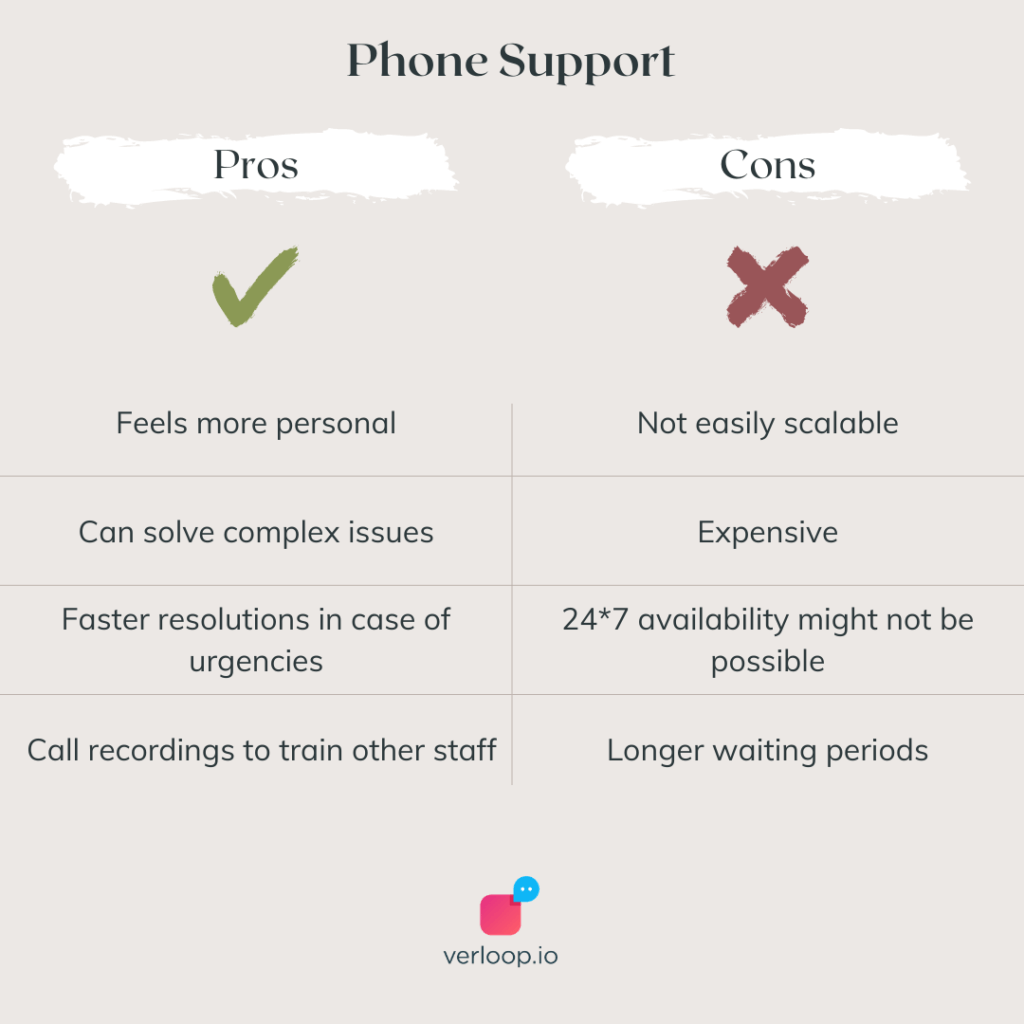
Cons of phone support
a. Not easily scalable: One agent can handle only one call at a time. Therefore, scaling needs a lot more resources than deploying a piece of software. Scaling up requires not only increased hiring but more space and equipment as well.
a. Expensive: The number of agents required to resolve an issue is always higher in the case of phone support. This leads to higher operational costs as you are hiring more and training these agents to provide the best customer support. More agents mean more overhead costs as well.
c. 24*7 availability might not be possible: Humans need to sleep and have some leisure time for themselves. Phone support agents work during business hours and cannot be available every time you give them a call.
d. Longer waiting periods: In the peak hours, lines can get a lot busier than non-peaks time. That results in customers having to wait longer to get a response from a customer service provider and eventually a bad experience.
What is conversational AI support?
Have you ever noticed a chat window popup on the sides of some website you browse? That is not a human offering to help but a bot deployed by the organisation as the first point of interactive customer care.
In the past, chatbots were simple and thus unable to handle the dynamics of customer interaction. Things are changing now with the recent breakthroughs in the field of Artificial Intelligence.
Conversational AI is AI-powered software that is intelligent enough to carry out a human-like conversation in the form of text, voice and gesture.
The obvious advantage over previous bots is that it is far abler to carry out natural conversations. Most of the time, the customer does not even know if they are actually talking to a person or a machine.
Pros of Conversational AI
a. 24*7 support: The most obvious advantage is that a conversational chatbot is available round the clock for support. You could ask a bot for help at any hour suitable to you. Even customers consider round the clock availability as the biggest advantage of using a website with a chatbot.
b. Scalability: A conversational AI platform can handle multiple chats at a time. And it also encourages customers to resolve queries on the frequently asked questions independently. This way, they can address more support queries and reduce the load on human agents.
c. Costs: Conversational AI platforms are hands down one of the cost-friendly customer support methods available today. Because they automate processes and don’t require regular training, they can reduce up to 30% of the usual costs.
d. Customers’ preference: The newer generation is more inclined towards text messages than having a telephonic conversation with customer support services. Conversational AI platform can also talk to your customer on their preferred channel of communication, be it website, mobile app, WhatsApp or social media sites like Facebook.
Conversational Chatbots see high engagement and can get a response rate of as high as 80-90%.
e. Intent and emotion recognition: Companies can train the AI behind the conversational platform to understand the intent behind the customer’s questions and analyse the emotions in their text or voice messages.
f. Analytics: Collecting data and analysing user behaviour is much simpler through a conversational AI platform. With this data, you can predict issues before the gain scale and proactively communicate with users.
g. Proactive communication: A conversational AI platform can be used to proactively communicate with customers, before they come across an issue with your product or service.
h. Efficiency: Using a conversational AI platform, the agent’s efficiency increases. Since they don’t get the monotonous, repeated queries, they can improve their productivity and focus on complex problems with a personalised touch.
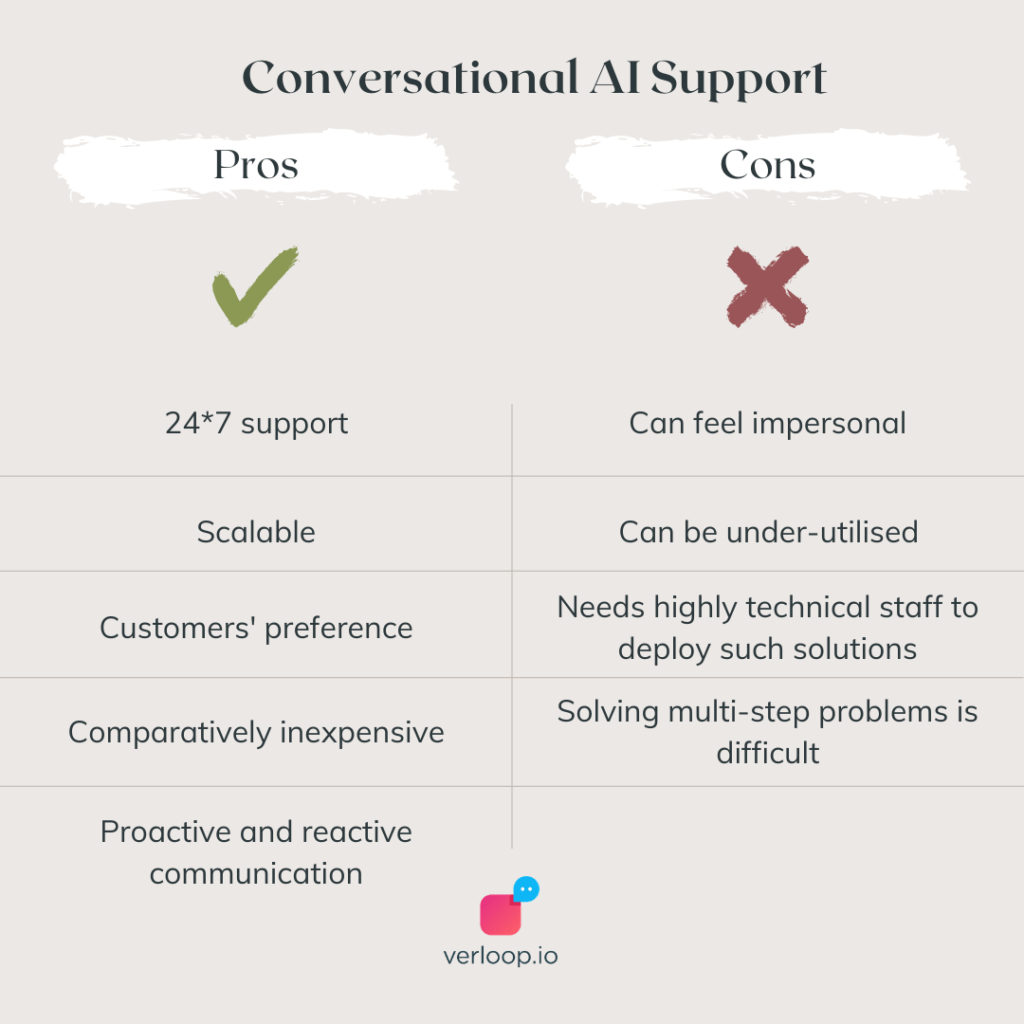
Cons of Conversational AI
a. Can feel impersonal: Chats can feel more disconnected than a phone call. AI has made things better in this regard than simpler bots. Yet, if the AI is not trained well, texts generate much lesser emotions when compared to a voice call.
b. Solving multi-step problems is difficult: Generally, chats are suitable for solving simple problems. Again, not all conversational AI platforms have the ability to identify multiple intents in one question.
c. Improper use cases – Businesses don’t understand the conversational AI well enough and end up using it where it’s not even needed. For example, deploying it on a channel where the customers don’t frequent.
d. Needs highly technical staff to deploy such solutions – The questions of whether you should build a conversational AI chatbot in-house or go for a third-party provider can be a difficult choice. If building in-house, you need a team of AI and security specialists who understand the industry use cases well.
Key differences in phone vs Conversational AI support
Now that we’ve understood the pros and cons of both phone and conversational AI support, let’s look at how they differ from each other.
We will cover five important points that can help you understand the key differences.
a. Personal vs impersonal
Once a customer gets through a call, phone support is more personal as the human agent can add emotion and empathy to the conversation. On the other hand, a conversational AI platform is as good as its data set, which is used to train it.
b. Proactive vs reactive
The main difference between conversational AI and call support is that you always have to initiate a call when you need help. Chat support, however, always lets you know that it is there with a proactive popup without disturbing your work.
Conversational AI support can also let you preemptively send messages when you know there is an issue, like downtime or a payments-related issue.
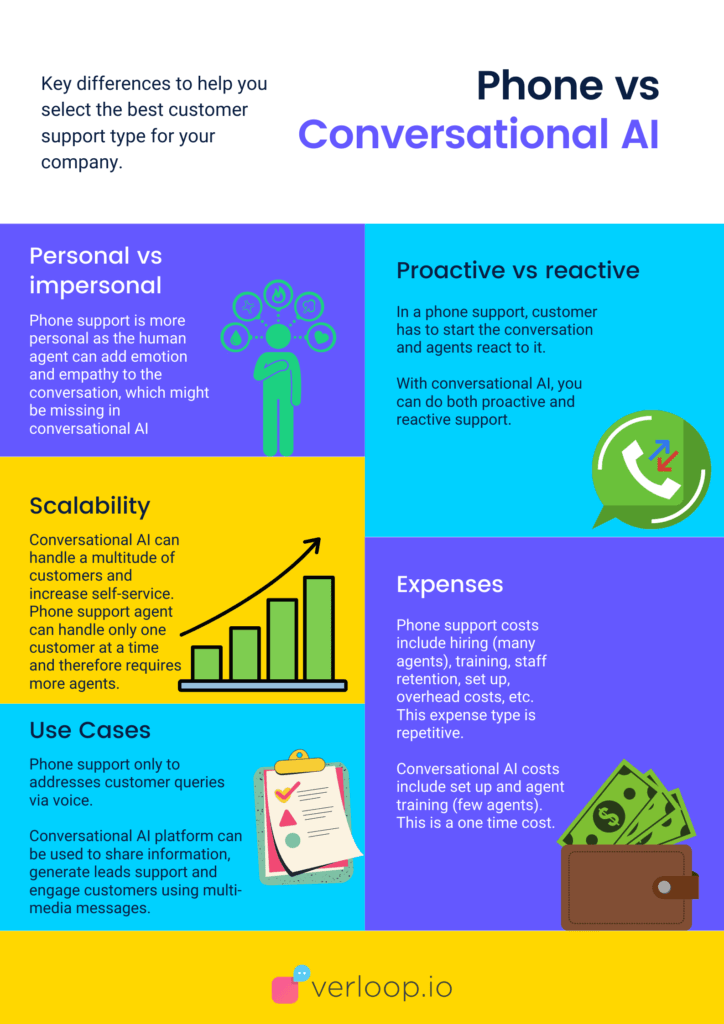
c. Scalability
Conversational AI can handle a multitude of customers at the same time. The same is not possible for call executives. If there is a sudden spike in customer queries, phone support is bound to fail without a proportional increase in resources spent.
AI chat support is much more elastic in such a case. And even when the scaling will be required, it would be far easier and cost-friendly to do that. Plus, conversational AI support is available 24×7 to address customer queries.
d. Expenses
While setting up call support, you need to spend on hiring agents, training them, setting up their equipment, etc. The overhead costs are many. And it doesn’t stop there. The staff turnover rate is high in call centres, so the hiring and training are repeated expenses.
On the other hand, a conversational AI has one time set up expense. Once it’s installed, a company needs to train its employees once. With the help of conversational AI, employee satisfaction is high and staff turnover low. Additionally, the company doesn’t need to hire more agents as it scales the customer support.
e. Use Cases
Phone vs conversational AI support serves different use cases. A phone support system is useful only to address customer queries. And this is done via voice.
In addition to addressing customer queries, a conversational AI platform can share information, generate leads and engage customers using multi-media messages. Companies can use text, voice, images, videos, pdfs, etc., to communicate with the user on multiple channels at customers’ convenience.
The winner in Conversational AI vs phone support
The heated debate around conversational AI vs phone support is not going to die soon. When we compare call and chat support, both happen to have their pros and cons.
Phone support is losing popularity with the generational shift but still has its fans. Chat support, on the other hand, is evolving with Conversational AI as the future.
It is, however, wrong to completely reject one in favour of the other. The best option, still, is to meet your customers where they are.
Verloop.io is a leading conversational AI platform that helps companies deliver delightful experiences to their customers. We have trained the AI to under multiple intents and on different industry’s use cases. Our conversational AI platform also allows customers to communicate using voice messages.
If this sounds interesting and you’d like to implement a conversational AI platform on your website, mobile, WhatsApp, and Facebook pages, let’s talk.





